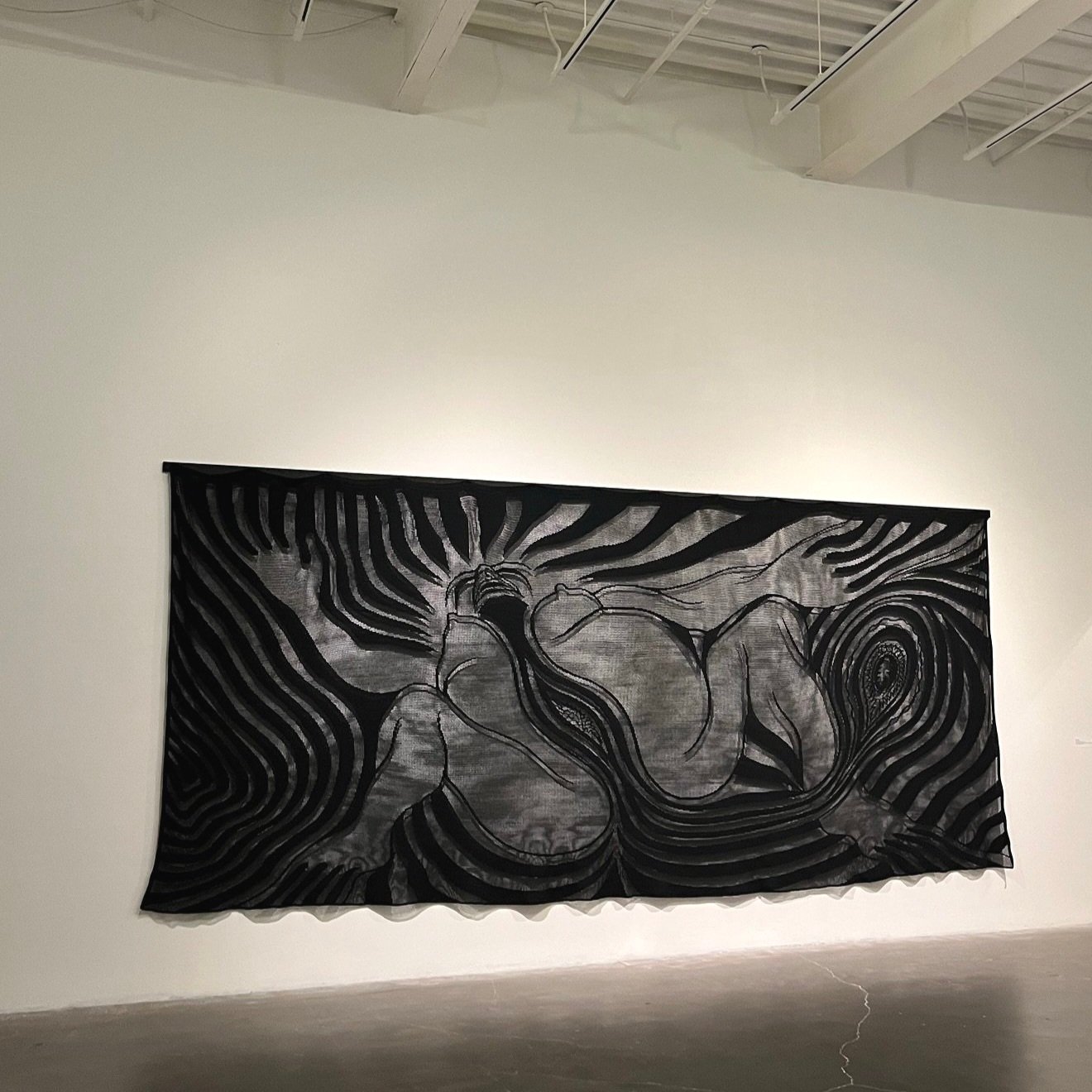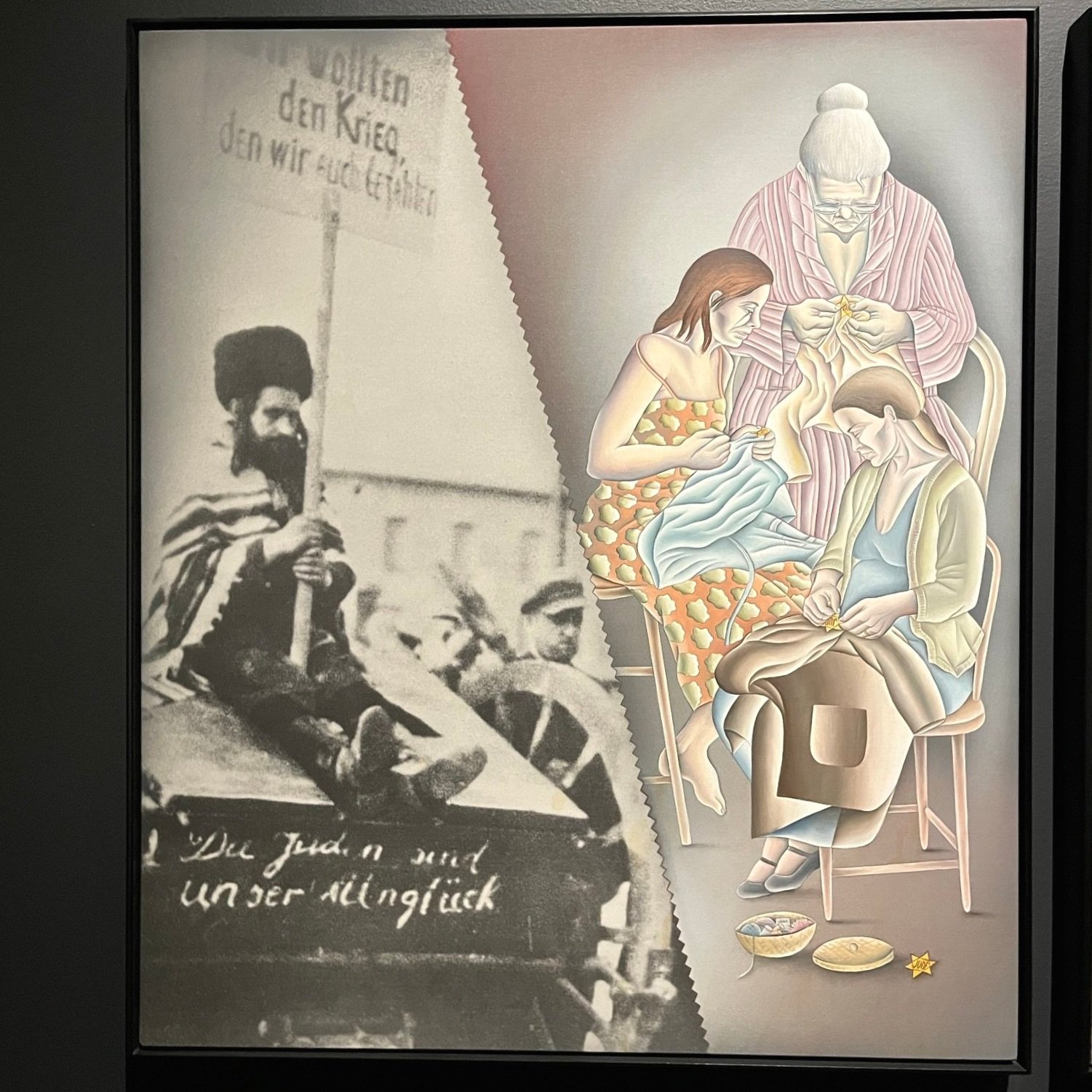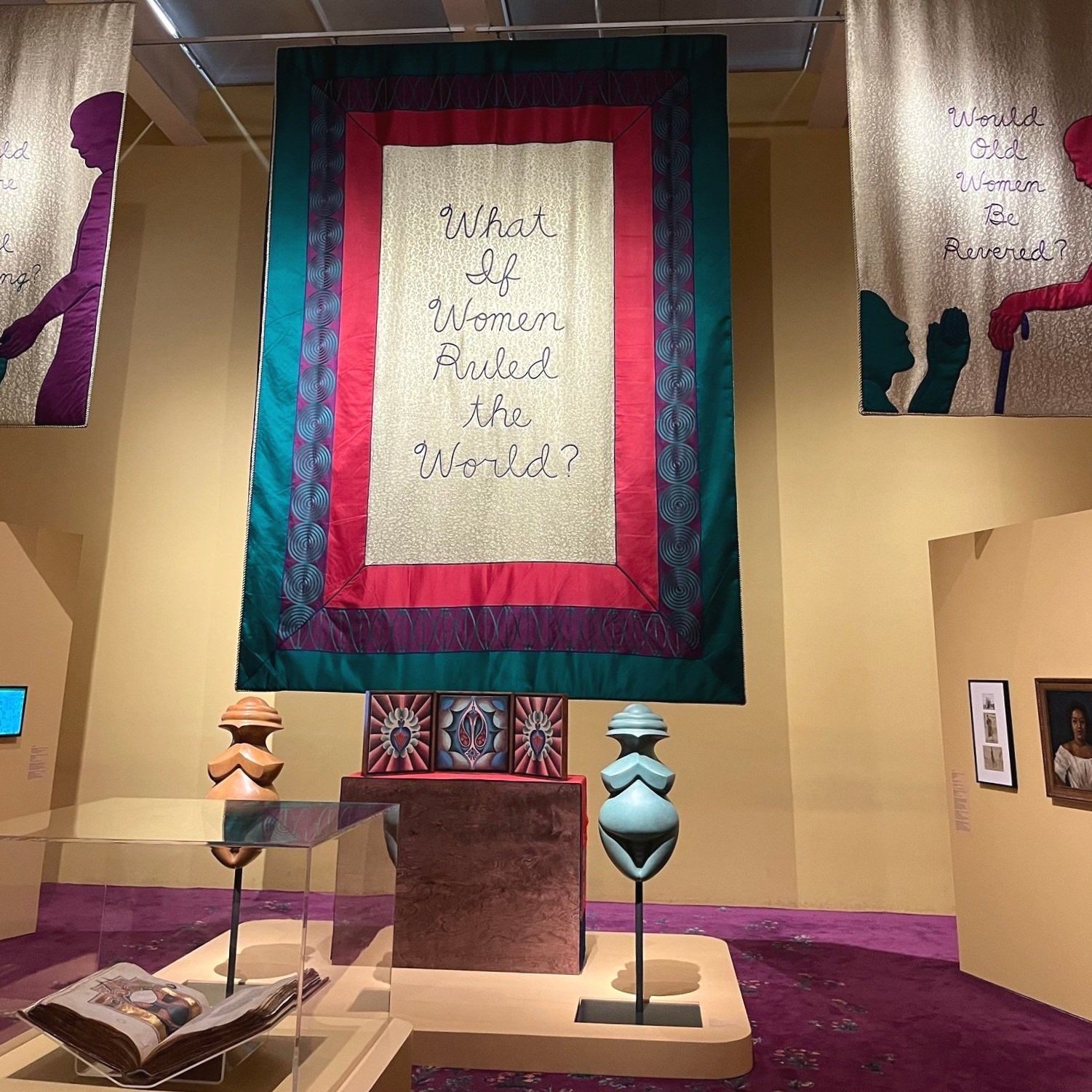Judy Chicago - ‘Herstory’
A confrontational story against the patriarchal norm
[Dutch version below the photo gallery.]
The New Museum presents 'Herstory,' the first retrospective in New York of the renowned feminist artist Judy Chicago. The exhibition highlights Chicago's six-decade-long career, emphasizing her battle against the norm. Her career began from a sense of outrage over the neglect of female artists in the art world at the time. Chicago's response resulted in an often explicit visual language with vulvas, wombs, ovaries, and female nudity as central elements that cannot be ignored. Consequently, Chicago encountered considerable criticism throughout her career, primarily from—surprise, surprise—male colleagues and critics.. 'Herstory' invites you into Chicago's mindset, highlighting her perseverance in confronting difficult subjects despite the hurdles she encountered.
Chicago was born in 1939 as Judith Cohen and grew up in Los Angeles in the 1960s, where she earned a Master's degree in painting and sculpture at UCLA. During her studies, she was shocked by the attitude of her male peers and professors. Female artists in art history were completely ignored, and her own work was labeled as ‘too feminine.’ ‘Herstory’ opens with ‘Car Hoods’ (1964-65). After completing her studies, Chicago enrolled in an auto body repair course, standing as the sole woman among 250 men. Chicago's reaction to the macho culture manifested in vibrant Chevrolet Corvair hoods, which featured rich compositions of vulvas, hearts, butterflies, and wombs. The irony of positioning female iconography on what was traditionally seen as a masculine object perfectly embodies Chicago’s approach.
Her rebellion against the minimalist movement of the 1960s, led by artists like Donald Judd, Richard Serra, and Carl Andre, is evident in the sculptures ‘Trinity’ and 'Rainbow Pickett' (both 1965). Perfect geometric figures in stainless steel were given a glossy, colorful finish. Chicago continued experimenting with geometric shapes and color in her 'Fresno Fan' and 'Pasadena Lifesavers' series from the late '60s to early '70s. Nothing is as it seems with Chicago. In the immaculate ring shapes of 'Pasadena Lifesavers,' she tried to capture the disintegrating sensation of orgasm. “O.”
From the 1970s onwards, Chicago shifted into higher gear. She changed her birth name to her birthplace, Chicago, in order to free herself from the patriarchy. She fully immersed herself in the feminist movement and became openly political. This led to a breath of fresh air in her work, as seen in the pyrotechnic performance series ‘Atmospheres’ (1968-74). Pigmented smoke clouds, fire, and fireworks spread over California's natural landscapes. Coloring the desert landscapes symbolized the feminization and the dismantling of male dominance over the land. Video footage and photographs in 'Herstory' show naked, paint-covered women emerging from smoke clouds in a desolate environment. These are powerful images that feel almost spiritual. The power and mysticism that distinguished ‘Atmospheres’ are missing in ‘Garden Smoke,’ a 2020 project during the COVID-19 pandemic. Reworkings of earlier projects may be interesting, but the small-scale smoke spectacles in a recognizable domestic setting lack depth. Words like ‘shutdown, entrapped, constrained, suppressed’ surround the photos, yet Chicago fails to convey those feelings in the project. This exhibition demonstrates that Chicago created her most powerful works when her political voice was loudest, often in collaboration with other women.
In 1972, Chicago teamed up with Miriam Schapiro and 21 students and local artists from the CalArts Feminist Art Program for the raw installation 'Womanhouse.' A dilapidated mansion in Hollywood was filled with installations, performances, and workshops expressing the reality of being a woman. No topic was off-limits. Among the rooms was a 'Menstruation Bathroom,' a virginal white room filled with used and bloody sanitary products. In ‘Herstory,’ 'Womanhouse' is brought to life through archival material that shows the pleasure and dedication of the women involved in the project.
The 1970s are crucial to Chicago's work. She discarded her earlier minimalist style in favor of a new visual language to express her experiences as a woman. Psychedelic, dizzying, bright, transcendent… these are just a few characteristics that describe the boldly designed paintings like ‘Through the Flower,’ ‘Heaven is for White Men Only,’ and the series 'The Great Ladies.' This period also inspired Chicago to research important women in history, which laid the foundation for her most successful—and most criticized—work, ‘Dinner Party.’
A search for Judy Chicago will inevitably lead to 'Dinner Party' (1974-79). A monumental installation of three tables arranged in a triangle, with 39 places set for female artists. Each carefully arranged setting features an embroidered banner with the guest's name and a hand-painted ceramic plate. Nearly every plate features an abstracted cabbage, butterfly, starfish, artichoke, or orchid—symbols of the vagina. Beneath the tables, white tiles are inscribed with the names of 999 other women, written in gold. No matter your opinion of the work, it deserves recognition on several levels: the phenomenal collaboration of all the women involved in the project, the bringing together of all the crafts that were considered 'women's work' in a single installation, and, of course, the spotlighting of women in the work itself. Aside from a few sketches for the plates, 'Dinner Party' is notably absent in ‘Herstory,’ but the installation can be seen at the Brooklyn Museum, where it has been permanently housed since 2007.
Researching birth experiences and the lack of realistic representation of them in art history resulted in the ‘Birth Project’ (1980-85). This series of massive tapestries was the result of collaboration with craftswomen. The depictions of women giving birth leave nothing to the imagination. The series also marks the beginning of Chicago’s shift from abstract to figurative language.
The figurative works from the 1980s show another side of Chicago. 'Herstory' displays the ‘PowerPlay’ paintings (1982-87) in a rather confined space, making the already aggressive and toxic depictions of men feel even more intense. Is such a venomous portrayal of toxic masculinity necessary? The value of the ‘Holocaust Project’ (1985-93), which Chicago created with her husband, is also lost. Does combining figurative images with archival photos of the Holocaust add any meaning? Such historical trauma speaks for itself, and the combination with cartoonish still lifes is difficult, if not impossible, to understand. In a completely different series, ‘Resolutions: A Stitch in Time’ (1994-2000), Chicago offers her take on old-fashioned sayings and visions such as ‘Home Sweet Home’ and ‘A Chicken in Every Pot.’ She places them in a multicultural and contemporary perspective. The textile works bring a faint smile but miss their mark as social activism.
The retrospective, remarkably, is not just about Chicago but also includes a "museum-within-a-museum" exhibition. 'The City of Ladies' is an installation with works by over 80 female, non-binary, and trans artists, including Frida Kahlo, Hilma af Klint, Georgia O'Keeffe, Dora Maar, Leonora Carrington, Käthe Kollwitz, Artemisia Gentileschi, and others. It was decided not to include any living artists, as any exclusion would carry more meaning. It’s a catalog of Chicago’s inspiration and research into historical predecessors. There’s little cohesion between the pieces, so it can seem somewhat messy, but it remains a highlight of ‘Herstory’ because of the quality of each individual work. The works are displayed on light yellow walls above a plush, magenta floral carpet. Above, large banners that Chicago created for a 2020 Christian Dior haute couture show hang. Questions such as "What If Women Ruled the World?", "Would There Be Violence?" and "Would Old Women Be" are embroidered on the canvases. These questions are also part of a participatory work on the museum’s upper floor in collaboration with Nadya Tolokonnikova of the activist feminist art collective Pussy Riot.
After visiting ‘Herstory’, it is impossible not to respect Judy Chicago. Her works are rarely subtle. The subjects Chicago tackles require provocation. Feminism, social activism, birth, mortality… Avoiding confrontation means avoiding change. The controversy and discomfort triggered by her works highlight their significance. Not all of her projects are a hit, but 'Herstory' resonates deeply.
Judy Chicago ‘Herstory’ is on view at the New Museum until March 3, 2024.
235 Bowery, New York, NY 10002, Verenigde Staten
Photos(c) Cultuurtoerist, unless otherwise stated.
New Museum presenteert met ‘Herstory’ voor het eerst in New York een retrospectief van de befaamde feministische kunstenares Judy Chicago. De overzichtstentoonstelling van Chicago’s zestigjarige oeuvre belicht haar strijd tegen de norm. Haar carrière is gestart vanuit een verontwaardiging over de verwaarlozing van vrouwelijke artiesten in de toenmalige kunstwereld. Chicago’s reactie resulteerde in een vaak expliciete beeldtaal waarbij er niet omheen vulva’s, baarmoeders, eierstokken en vrouwelijk naakt kan gekeken worden. Hierdoor kreeg Chicago doorheen haar loopbaan bakken kritiek, voornamelijk van - je raadt het al - mannelijke collega’s en recensenten. ‘Herstory’ neemt je mee in Chicago’s denkwijze en strijd om ongemakkelijke onderwerpen aan te kaarten ondanks alle hindernissen op haar pad.
Chicago werd in 1939 geboren als Judith Cohen en groeide op in het Los Angeles van de jaren 1960, waar ze een masteropleiding schilderen en beeldhouwen behaalde aan UCLA. Tijdens haar opleiding was ze ontsteld door de houding van haar mannelijke medestudenten en docenten. Vrouwelijke artiesten in de kunstgeschiedenis werden volledig genegeerd en haar kunst werd omschreven als ‘te vrouwelijk’. ‘Herstory’ opent met ‘Car Hoods’ (1964-65). Na haar studies volgde Chicago, als enige vrouw tussen 250 mannen, een opleiding autoschadeherstel. Haar antwoord op de machocultuur kreeg de vorm van Chevrolet Corvairs’ motorkappen gespoten in snoepkleuren. Op de motorkappen zijn weelderige composities van vulva’s, harten, vlinders, baarmoeders… te zien. De ironie van het plaatsen van vrouwelijke iconografie op wat als een overwegend mannelijk object beschouw werd, typeert Chicago.
Haar rebellie tegen de minimalistische beweging van de jaren ‘60 met koplopers als Donald Judd, Richard Serra, Carl Andre… zien we in de sculpturen ‘Trinity’ en ‘Rainbow Pickett’ (beide 1965). Perfecte geometrische figuren in roestvrij staal kregen een glanzend kleurrijk laagje. Chicago zette experimenten met geometrische vormen en kleur verder in haar ‘Fresno Fan’ en ‘Pasadena Lifesavers’ series uit eind jaren ‘60 – begin jaren ‘70. Niets is wat het lijkt bij Chicago. In de smetteloze ringvormen van ‘Pasadena Lifesavers’ probeerde ze de ontbindende sensatie van het orgasme te bevatten. “O”.
Vanaf de jaren 1970 schakelt Chicago een versnelling hoger. Ze verandert haar geboortenaam naar haar geboortestad, aldus Chicago, om zich te ontdoen aan het patriarchaat. Ze gooit zich ten volle in de feministische beweging en wordt openlijk politiek. Haar werk kreeg hierdoor een nieuwe adem zoals te merken is in de pyrotechnische performancereeks ‘Atmospheres’ (1968-’74). Gepigmenteerde rookwolken, vuur en vuurwerk verspreiden zich over de natuurlandschappen van Californië. Het kleuren van de woestijnlandschappen symboliseert het feminiseren en ontdoen van de mannelijke overheersing van het land. Videobeelden en foto’s bij ‘Herstory’ tonen naakte, met verf bedekte vrouwen die in rookwolken verschijnen in een desolate omgeving. Het zijn sterke beelden die haast spiritueel aanvoelen. De kracht en mystiek die ‘Atmospheres’ onderscheidde, ontbreekt bij ‘Garden Smoke’, een project uit 2020 tijdens de COVID-19 pandemie. Herwerkingen van vroegere projecten kunnen interessant zijn. De kleinschalige rookspektakels in herkenbare huis-tuin omgeving missen echter diepgang. Begrippen als ‘shutdown, entrapped, constrained, suppressed’ zijn weergegeven rondom de foto’s. Maar Chicago slaagt er niet in om die gevoelens over te brengen in het project. Deze tentoonstelling demonstreert dat Chicago haar sterkste werken creëerde wanneer ze haar politieke stem het luidst liet horen en dit meestal in samenwerking met andere vrouwen.
Zo bundelde Chicago in 1972 haar krachten met Miriam Schapiro en 21 studenten en lokale kunstenaars van het CalArts Feminist Art Program voor de rauwe installatie ‘Womanhouse’. Een vervallen herenhuis in Hollywood werd gevuld met installaties, vertoningen en workshops die de realiteit van het vrouw zijn uitdrukken. Geen enkel onderwerp werd geschuwd. Zo was er een ‘Menstruation Bathroom’, een maagdelijk witte kamer vol met gebruikte en bebloede toiletartikelen. In ‘Herstory’ wordt ‘Womanhouse’ aan de hand van archiefmateriaal gebracht waaruit het plezier en toewijding van de vrouwen die deel uitmaakten van het project blijkt.
De jaren ’70 zijn essentieel voor Chicago haar werk. Chicago gooide haar eerdere minimale stijl in schilderijen overboord en vond een nieuwe beeldtaal om haar ervaringen als vrouw uit te drukken. Psychedelisch, duizelingwekkend, helder, transcendent,.. Het zijn maar enkele kenmerken die de gedurfd vormgegeven schilderijen als ‘Through the Flower’, ‘Heaven is for White Men Only’ en de reeks ‘the Great Ladies’ zouden kunnen omschreven. Het stimuleerde Chicago om onderzoek te voeren naar belangrijke vrouwen in de geschiedenis wat de basis vormde voor haar meest succesvolle en tegelijkertijd meest bekritiseerde werk ‘Dinner Party’.
Een zoekopdracht naar Judy Chicago zal steeds leiden tot ‘Dinner Party’ (1974-’79). Een monumentale installatie uit drie tafels geplaatst in een driehoek voorziet 39 plaatsen voor vrouwelijke kunstenaars. Elke zorgvuldig gedekte plaats heeft een geborduurde spandoek met de naam van de gaste en een handgeschilderd bord van keramiek. Op quasi elk bord staat een geabstraheerde kool, vlinder, zeester, artisjok of orchidee oftewel allemaal symbolen voor – moet het nog verduidelijkt worden? – de vagina. Op witte tegels onderaan de tafels staan de namen van 999 andere vrouwen, geschreven in goud. Welke mening je ook hebt over dit werk, het verdient erkenning op meerdere vlakken: de fenomenale samenwerking van alle vrouwen aan dit project, het samenbrengen van alle ambachten die als ‘vrouwenwerk’ aanzien werden in één installatie en uiteraard het belichten van de vrouwen in het werk zelf. Naast enkele schetsen voor de borden, is ‘Dinner Party’ opvallend afwezig in ‘Herstory’ maar de installatie kan wel in Brooklyn Museum bezocht worden waar het sinds 2007 permanent onderdak heeft.
Onderzoek naar ervaringen van de geboorte en het gebrek aan een realistische weergave ervan in de kunstgeschiedenis leverde ‘Birth Project’ (1980-’85) op. De reeks gigantische wandtapijten was het resultaat van een collaboratie met handwerksters. De weergaven van vrouwen die geboorte geven, laten niets aan de verbeelding over. De serie markeert daarnaast het begin van Chicago’s verschuiving van abstracte naar figuratieve taal.
De figuratieve werken van de jaren 1980 tonen een andere kant van Chicago. ‘Herstory’ geeft de ‘PowerPlay’ schilderijen (1982-’87) weer in een vrij nauwe ruimte waardoor de al zeer agressieve en giftige afbeeldingen van mannen nog heftiger aanvoelt. Is zo’n nijdige weergave van toxische masculiniteit nodig? Ook de waarde van het ‘Holocaust Project’ (1985-’93) die Chicago samen met haar man creëerde, ontgaat volledig. Heeft het combineren van figuratieve beelden met archieffoto’s van de Holocaust enige betekenis? Dergelijk historisch trauma is op zichzelf al sprekend genoeg, de combinatie met cartooneske stillevens is moeilijk tot niet te begrijpen. In een geheel andere reeks ‘Resolutions: A Stitch in Time’ (1994-2000) geeft Chicago haar kijk op ouderwetse spreuken en visies zoals ‘Home Sweet Home’ en ‘A Chicken in Every Pot’. Ze plaatst deze in een multicultureel en hedendaags perspectief. De textielwerken brengen een flauwe glimlach teweeg maar missen hun doel als sociaal activisme.
De retrospectief draait opmerkelijk genoeg niet enkel om Chicago maar neemt ook een “tentoonstelling-in-een-tentoonstelling” op. ‘The City of Ladies’ is een installatie met werken van meer dan 80 vrouwelijke, non-binaire en transkunstenaars waaronder Frida Kahlo, Hilma af Klint, Georgia O'Keeffe, Dora Maar, Leonora Carrington, Käthe Kollwitz, Artemesia Gentileschi en anderen. Er werd beslist om geen enkele nog levende artiest op te nemen omdat elke uitsluiting dan meer betekenis zou krijgen. Het is een soort catalogus van Chicago’s inspiratie en onderzoek naar historische voorgangers. Er is weinig samenhang tussen de stukken waardoor het wat rommelig kan overkomen; desalniettemin is het een hoogtepunt van ‘Herstory’ door de kwaliteit van elk individueel werk. De werken worden tentoongesteld op lichtgele muren boven een pluche, magenta bloementapijt. Daarboven hangen grote banieren die Chicago maakte in voor een haute couture show van Christian Dior in 2020. Vragen als "What If Women Ruled the World?", "Would There Be Violence?” en “Would Old Women Be zijn geborduurd op de doeken. Deze vragen maken daarnaast deel uit van een participatief werk op de bovenste verdieping van het museum in samenwerking met samenwerking met Nadya Tolokonnikova van het activistische feministische kunstenaarscollectief Pussy Riot.
Na een bezoek aan ‘Herstory’ kan je niet anders dan Judy Chicago respecteren. Subtiel kan je haar werken meestal niet noemen. De onderwerpen die Chicago aansnijdt, hebben de provocatie echter nodig. Feminisme, sociaal activisme, geboorte, sterfelijkheid… Als je de confrontatie uit de weg gaat, zal je geen verandering teweeg brengen. De controverse en de ongemakkelijkheid die haar werken teweeg brengen, tonen net de relevantie ervan aan. Niet alle projecten zijn een schot in de roos maar ‘Herstory’ zal je niet onbewogen laten.































